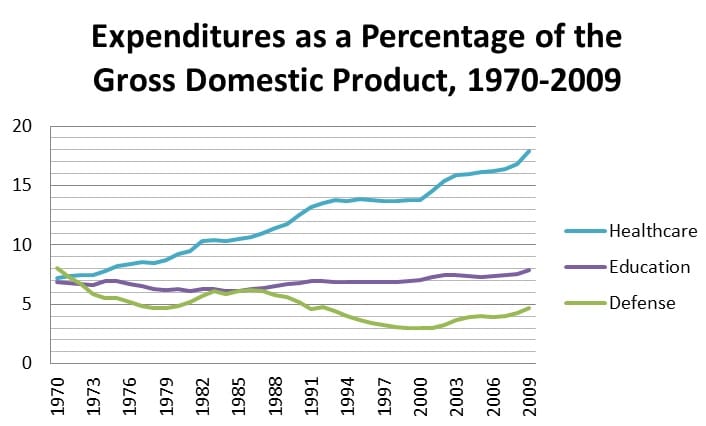Mitt Romney’s selection of one-time think-tanker Paul Ryan as his running mate has unleashed a torrent of “wonky mud-slinging,” says the press. It’s about time. The nation faces huge demographic and fiscal challenges—trends that will put ever-growing pressure on the public fisc in general, including the education budget. Yet rather than demonstrate the creative problem-solving skills that educators claim to be imparting to their students, their lobbyists are playing short-term politics with America’s long-term future.
You can either “ration” health care or you can “ration” education (and all other social spending). Take your pick.
The basic challenge—this is hardly news—is that America is aging and, as a result, is spending a lot of money on healthcare and retirement expenses. These expenses will go up and up in coming decades; they’re built into our demography. Unless economic growth can outpace the cost increase, however, that means less money for everything else—education included.
So let’s say you want to protect the education budget and other investments in the young—in the future. The first thing you need to do is constrain public outlays for the old—which mostly means holding the line on healthcare spending. And the second thing you need to do is encourage maximum economic growth. Get both of these things right and you avoid Armageddon.
Now hold on, you say, there are other options. You can go after the defense budget. You can raise taxes on the rich. That’s true, and these might help at the margins, at least for a while. But as the chart below shows, defense spending is hardly putting pressure on education spending—healthcare is. And as many economists will tell you, if you tax the rich too aggressively, you’ll drive down economic growth. You might slice the pie more evenly but a smaller pie means less for everyone. (And taxing the rich won’t raise nearly enough revenue, anyway.)
 Notes: Sources here, here, and here. Education spending is all government outlays for K-12 and higher education. Healthcare spending is all expenditures, public or private. |
Which brings us back to the real options:
- Rein in healthcare spending. President Obama says the Affordable Care Act will do that, but there are many skeptics. Ryan’s approach—capping the amount of healthcare the government will pay for—by voucherizing Medicare and block-granting Medicaid, would almost surely do more to drive down healthcare spending, making room for education and everything else. For Medicare especially, Ryan would stop Uncle Sam from writing blank checks for all the health care that seniors can consume. Yes, that would lead to a form of “rationing,” at least rationing the publicly-paid-for services. But you can either “ration” health care or you can “ration” education (and all other social spending). Take your pick.
- Grow the economy. There’s a debate to be had here, too, with Democrats urging investments in infrastructure and public employee salaries and benefits, and Republicans calling for a simplified pro-growth tax code and a bunch of deregulation. A mix of the two is probably the right prescription—but higher taxes over the long-term would almost certainly backfire.
Yet, unless I missed it, I don’t recall hearing the NEA or AFT or Committee on Education Funding calling for measures to slow down healthcare spending or kick-start the economy. Instead they are sticking to the same old argument, squawking about short-term cuts to the federal budget (which is a thin slice of all education spending anyway).
Just as Scott Walker’s purportedly “anti-educator” reforms freed up money in his state for more spending in the classroom, so would Paul Ryan’s “radical” reforms free up money for education nationwide. It’s too bad that the public-education lobby remains unwilling to acknowledge it.
